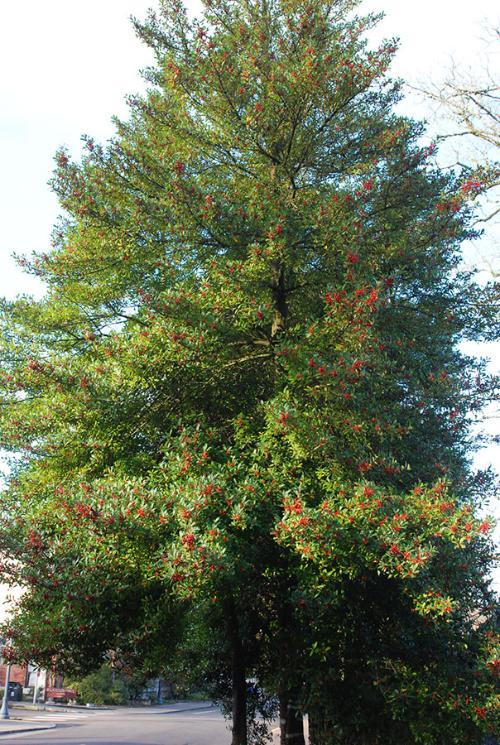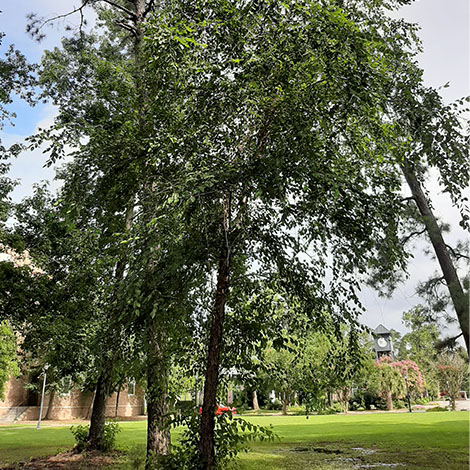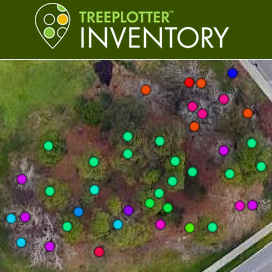CCU Arboretum
Foster Holly
 Common Name: Foster Holly
Common Name: Foster Holly
Scientific Name: Ilex attenuata var. ‘Foseri’
Species Range: Foster Holly is a hybrid of Ilex cassine and Ilex opaca. It is native to the the eastern, southern, and western United States. It ranges from Massachusetts to Florida, west to California, and north to Washington. It is typically found in coastal regions and areas safe from harsh winter conditions. Foster Holly grows in USDA Hardiness Zones 6 - 9.
Growth Characteristics: Foster Holly, also known as Topel Holly, reaches heights of 15’- 30’ with a spread of 8’- 20’. This broadleaf evergreen grows in a pyramidal to conical shape and its growth rate can range from slow to fast depending on the location. Some sources suggest annual growths of 12” - 24” on average. It thrives in full sun to partial shade and in a variety of soil conditions. These conditions can range from acidic to alkaline, well-drained to dry, clay, loamy soils, although it is important to steer clear of poorly drained soils. The use of mulch is recommended to hold onto moisture in the soil. Fruit production is higher in full sun conditions, but partial afternoon shade is recommended in particularly hot climates. It produces showy, vibrant red berries that remain through winter; these berries are quite small, less than an inch in both length and width. Foster Holly’s inconspicuous blooms occur from April to May in shades of white to cream. Its glossy, waxy foliage ranges from green to dark green. They are simple with an alternate arrangement, wedge-shaped at the base, and typically elliptic to ovate, ranging from 1”-3” in length and <1” in width. The foliage has a spinose structure, and the spines are on the upper portion of the leaf.
Ecosystem Service Value: Both Foster Holly fruit and foliage is sought out by birds and small mammals while the flowers mainly attract bees. Foster Holly also supports the specialized bee Colletes banksi.
Uses, Other Details: It is typically used as a hedge, screen, or shade tree. They are often planted in small groups. Its persistent color also makes it a good choice for landscaping.
Threats: Holly leaf miner, spittlebugs, spider mites, whitefly and scale are all common pests that can cause damage to Foster Holly foliage. Diseases may range from leaf spot and rot, tar spot as well as powdery mildew. Leaf drop and scorch may damage the foliage. Chlorosis can occur due to high soil pH levels.
Identification Tips and Tricks: It’s conspicuous, red berries and spiny leaves are indicators for the Foster Holly.
Species profile by Audrey Nelson
References:
Foster's No. 2 Hollyilex x attenuata 'Fosteri'. (n.d.). Retrieved March 21, 2021, from https://www.arborday.org/trees/treeguide/TreeDetail.cfm?ItemID=851#:~:text=2%20HollyIlex%20x%20attenuata%20'Fosteri'&text=An%20excellent%20evergreen%20for%20use,male%20pollinator%20for%20fruit%20development.
Ilex X attenuata 'Fosteri'. (n.d.). Retrieved March 21, 2021, from https://plants.ces.ncsu.edu/plants/ilex-x-attenuata-fosteri/#:~:text=Foster's%20Holly%20is%20a%20small,resistant%20to%20damage%20by%20deer.
Ilex × attenuata 'FOSTERI' - Plant Finder. (n.d.). Retrieved March 21, 2021, from http://www.missouribotanicalgarden.org/PlantFinder/PlantFinderDetails.aspx?kempercode=q190








